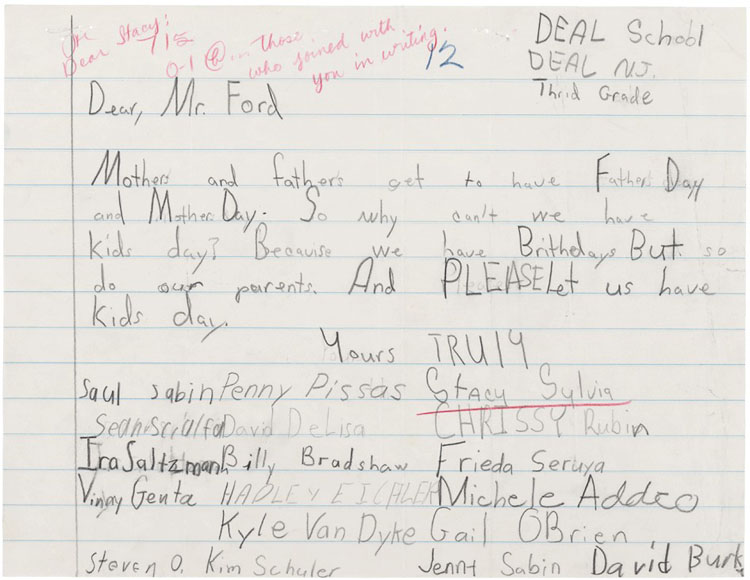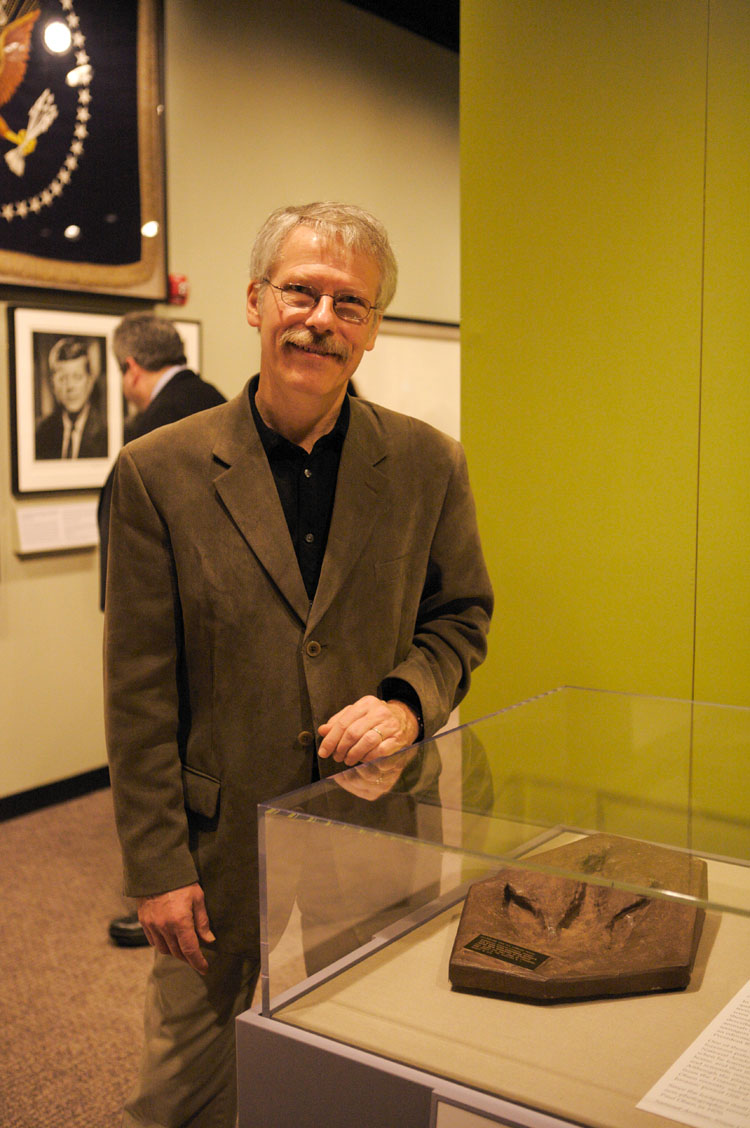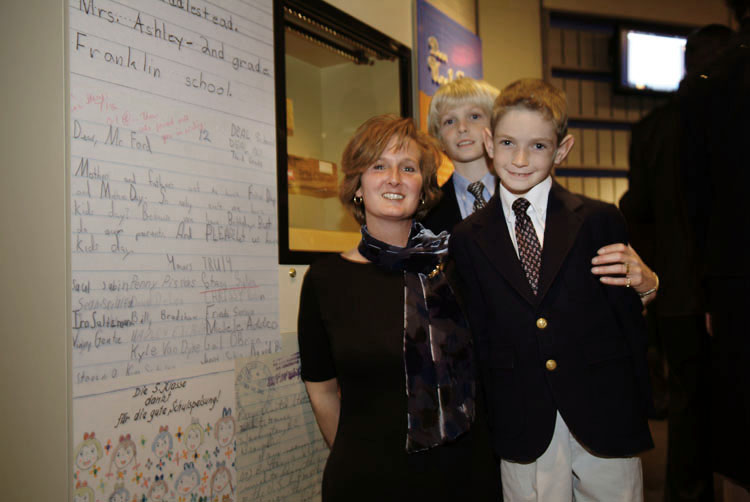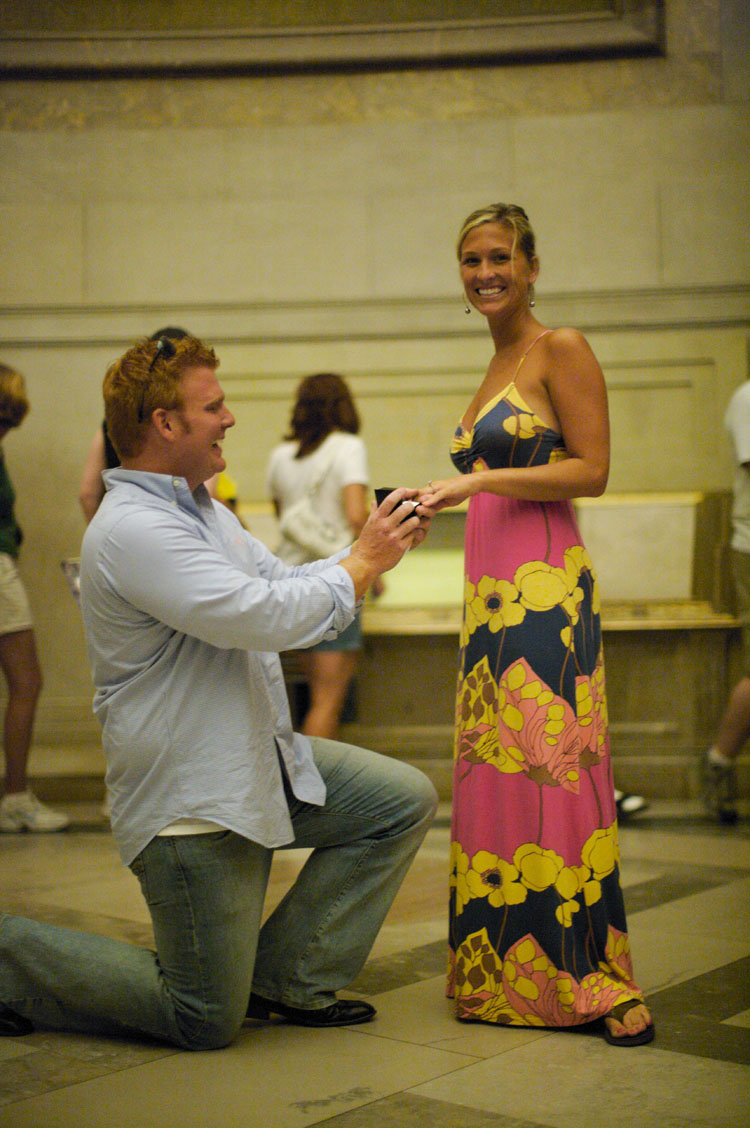
A Place in the Archives
Winter 2009, Vol. 41, No. 4
By Miriam Kleiman
Nearly every American's name is mentioned somewhere in the holdings of the National Archives—in census records, military and civilian personnel files, records of payments of government entitlements.
But few Americans' lives intersect publicly with the National Archives. And sometimes, lives do intersect more than once, as they did in these three cases.
Fifteen-year-old Paul Olsen wrote to President Richard M. Nixon about his discovery of historic dinosaur tracks near his home—and even sent him a fiberglass impression of a footprint.
A letter to President Gerald R. Ford seeking a holiday in honor of "kids," from Gail O'Brien and her fellow third graders in New Jersey, got a official response.
Two Ohio middle-schoolers visited the Rotunda for the Charters of Freedom at the National Archives to see the Declaration of Independence. Years later, the Rotunda became the site of their marriage proposal and acceptance.
What follows are three stories of people whose lives intersected with the National Archives first as children and then as adults—in significant and unexpected ways.
Leaving a Big Footprint
In 1968, when the discovery of dinosaur tracks in an abandoned quarry in Roseland, New Jersey, made the local news, two teenage boys in a nearby town jumped on their bicycles and went to investigate. Working on their own, they uncovered thousands of fossilized dinosaur tracks, which an expert later described as "something of a milestone in the history of these animals because of the large number of tracks."
A year later, Paul Olsen, one of the dinosaur hunters, wrote the first of many letters to President Richard Nixon. Identifying himself as one of a group of "young geologists" at the Roseland quarry, Olsen began an extended lobbying and media campaign to make the quarry a protected park area. He described their digs and included drawings of some of their Triassic-era finds. While the surrounding area was protected as park land, Olsen wrote that the quarry itself was not. He urged that it be "pressurved [sic] for all eternity for our country," and closed his letter with the guarantee: "Mr. President, I can assure you it is worth it!"
After having no luck getting New Jersey state officials to protect the area, Olsen continued his letter-writing campaign to the President, updating Nixon on both the ongoing dig and the status of the quarry. Local and state officials "all are in favor but all lack funds," he wrote at one point. He cited additional attempts to reach federal officials, being referred from one office to another, eventually to the Department of the Interior's Mesozoic Fossil Sites Division, from which he received no reply.
"We feel, Mr. President, that this matter deserves your personal attention," Olsen wrote, citing the President's State of the Union address lament of the rapid expansion of cities and suburbs and the need for preservation of parks and recreation areas:
Good fossil localities on the East Coast are rare and great ones even more so. It is a miracle that nature has given us this gift, this relic of the ages, so near to our culturally starved metropolitan area. . . . A great find like this cannot go unprotected and it must be preserved for all humanity to see.
The deputy director of the Interior Department's Mesozoic Fossil Sites Division responded to this letter. He praised Olsen's "dedication" and sent him the National Parks Service "Criteria for Parklands" booklet. He advised Olsen to gather letters from famous scientists in support of preserving the quarry.
Not to be deterred, Olsen wrote a comprehensive report, outlining in detail the history and discovery of the fossils found in the quarry. He attached to the report a stack of letters attesting to the importance of these finds—letters from top geologists and paleontologists at such renowned institutions as the American Museum of Natural History in New York and the Peabody Museum of Natural History at Yale University.
In one of these letters of support, the head paleontologist at the American Museum of Natural History praised Robert Salkin (director of a local fossils program who was mentoring the boys) for his support of Olsen and his friends: "One of these days one of them will see it through graduate school and you will then be particularly proud of your accomplishments."
Olsen shared these findings with local businesses, including Walter Kidde & Co., which owned the property with the quarry. The company, however, said that the tract of land was zoned for industrial purposes, and that all 53 acres, including the quarry, were available for sale as a unit.
However, another local business took up the cause. In July 1970, George Green, vice president of marketing for a Roseland company near the quarry, wrote to Nixon and suggested that Olsen and his friends be invited to the White House:
Possibly, an invitation to these young men to visit with you at the White House, Mr. President, would then show the good side of the young American students to the people of America.
Hugh W. Sloan, staff assistant to the President, responded a week later that "the demands of the President's schedule are such that we do not foresee a time when this could be arranged."
The ongoing dig, and the boys' persistence, lobbying efforts, and publicity eventually paid off. In November 1970, Walter Kidde & Co. donated 19 acres of land for what became the Walter Kidde Dinosaur Park. This land was then valued at more than a quarter million dollars.
The donated land, however, was not protected as a park. More help was needed on a national level, and additional funding was needed for protecting and preserving both the land and the fossils.
Green sent another note to Nixon, informing him of a December 11 LIFE magazine feature on the boys and stressing a political benefit from a White House meeting:
I personally am interested on the basis of seeing the young fellows with the "white hats" win once in a while just as I was interested in voting for you, Mr. President, because I feel that you are one of the fellows with the "white hat."
Paul Finkel, head of public relations at Kidde, appealed to Herbert Klein, White House communications director. He offered to bring Olsen and his friends to the White House, along with the chair of the Kidde's board of directors, to present one of the large dinosaur tracks to Nixon. Finkel stressed the value of such a photo opportunity: "News photos of the President and the boys would certainly help underline Mr. Nixon's theme."
In response to these more direct appeals to Nixon's image and reputation, Klein sent a memo to Sloan, noting that "this proposal does merit some consideration as a way of emphasizing the President's interest in the efforts of young people and his appreciation of their work in behalf of the community."
One week later, Sloan sent an internal memo to top White House advisers asking them to respond "yes" or "no" to the question: "Do you recommend the President receive a dinosaur track from these two boys during an Open Hour?"
Supporting the idea were presidential science adviser Ed David, White House counsel Len Garment, and Nixon's top environmental adviser John Whitaker, who wrote "Good chance for Pres. to plug his own park program." Opposed were presidential aides Pat Buchanan, William Safire—who scribbled "too obvious a joke about 'the Neanderthal Wing' etc."—and Bob Finch, who warned "bad symbolism!"
With a tie score, Sloan sent a memo to John Ehrlichman, who voted "no" and thus ended Olsen's chance of a White House visit. Sloan officially replied to both Finkel and Green the next day, stating that President's schedule was full but promised to "keep this in mind should an opportunity arise."
Undeterred, Kidde's PR man Finkel wrote again to Sloan the following week and asked him to reconsider. Finkel enclosed the LIFE magazine feature and told him that Olsen and a friend had been taped for the To Tell the Truth show that aired March 18, 1971.
Instead of an invitation to the White House, on January 20, 1971, Olsen received an official Presidential Commendation for his work, noting that the quarry had been put up for consideration as a national landmark.
In June 1971, the site received landmark designation. While this conferred status, it offered no legal protection for the site. Olsen again wrote to Nixon that summer. He politely thanked the President for both the commendation and designation but said they were not enough. While the award and the resulting publicity were positive, "at this moment . . . the Dinosaur Quarry is still not protected, still not a park."
Olsen outlined the challenges posed to the state and county in losing nearly 20 acres of taxable property but stressed the urgency in protecting this land. He again thanked the President for his commendation, but warned that his work "shall be all in vain unless the Dinosaur Quarry becomes a park." He pleaded for the President to "take an interest in this amazing find and help protect it for all these Americans who take pride and interest in our history and natural heritage."
On June 29, 1972, Olsen sent Nixon a very nice thank-you note for both the Presidential Commendation and for the efforts by the President and the Department of the Interior regarding the quarry. "As a token of our thanks," he sent a fiberglass cast of a 200-million-year-old dinosaur track—that of a Eubrontes giganteus, a theropod (beast-footed) dinosaur that would have stood approximately nine feet high. The gift eventually ended up in the National Archives' Nixon Presidential Library and Museum in Yorba Linda, California.
One year later, the fossil site was officially added to the National Registry of Natural Landmarks. The land is now owned by Essex County, New Jersey.
While preparing the National Archives exhibit, " BIG!," curator Stacey Bredhoff located the teenager who had lobbied Nixon. The call from the National Archives more than 35 years later "came as quite a shock" to Olsen. His initial reaction was "what footprint?" because "I had actually forgotten that I had sent the footprint to Nixon in the first place."
As an undergraduate at Yale, Olsen wrote and published papers on his fossil discoveries. He received a doctorate in biology from Yale in 1984. Today, as a professor at Columbia University, he is one of the nation's foremost paleontologists. He was recently elected a member of the National Academy of Sciences. He recalls that he "went ballistic" when he learned about the discovery of the tracks near his home and that the experience opened up a world of scientists and scientific resources that determined the course of his career.
Although the plaque imbedded in the cast dates the footprint from the Triassic period (248 to 206 million years ago), Olsen recently stated that it is now thought to be from the early Jurassic period (206 to 144 million years ago). Olsen as a featured speaker at the March 16, 2009, "BIG!" press preview and spoke at length with numerous reporters and staff about this boyhood exploration that changed his life.
That [dinosaur] footprint may not be very large, but for a kid who was 15 years old, finding a fossil like that, and then having communication with a President, and receiving a commendation, sending it [the cast of the print] off, and ultimately having it be in the National Archives, that was a really BIG event. On Monday, April 27, 2009, Olsen brought his wife, Annika, and their two sons, Gustaf and Max, to the National Archives. Before seeing the Charters of Freedom, the family viewed the now-famous cast of the dinosaur track. "Really cool!" both boys exclaimed. "It's definitely really cool."
How About a Kid's Day?
The "Dear Uncle Sam" section of the Public Vaults consists of children's letters to government officials, often offering tips or guidance. One amusing letter posed a question that has long vexed children: why are there Mother's and Father's Days but no Kid's Day?
In 1974, a third-grade class at Deal Elementary School in Deal, New Jersey, wrote to President Gerald R. Ford with an unusual request. Gail O'Brien barely remembers the letter her class wrote, but she does fondly recall her teacher that year, Joyce McGreevey.
Joyce McGreevey's third-grade English curriculum included a unit on letter writing, and the students practiced informal and formal correspondence. McGreevey urged her students to write to "important people."
Letters to state officials sometimes went unanswered. But letters to the White House—those were different. The White House always responded, much to the delight of McGreevey and her students. In 1974, the entire third grade at Deal Elementary was just a single class with 18 students. They all signed the letter to Ford asking for a Kid's Day, mailed it, and waited each day for the mailman to arrive at the school. The response from the White House was followed by a class celebration.
In the summer of 2004, O'Brien was surprised and thrilled to learn that this letter is part of the Archives permanent exhibition, the Public Vaults:
Who knew our 30 year old letter would end up in a permanent display in the National Archives? Who knew that when our 3rd grade class assignment to write a letter to our President . . . asking for a legal holiday for all children (KIDS DAY) that anyone was really listening?
O'Brien shared this exciting news with her family and friends—including many of her former third-grade classmates. O'Brien now has two children of her own. She stays in touch with many of her elementary school friends as well as her third-grade teacher McGreevey, who retired in 1995, after 36 years at Deal Elementary.
In November 2004, O'Brien and her sons were honored guests at the opening of the Public Vaults. Her sons performed the "ribbon cutting" that officially opened the exhibition.
She later wrote about the importance of this event in their lives:
My children Harry 10 and Haydn 7 at the time were about the same age I was when we wrote the letter—so both boys were able to share the experience with me. [Archivist] John Carlin asked the boys to help with the ribbon cutting ceremony. I think that was their favorite part! It was truly an honor to be there that weekend to trace our past as well as our country's past. I am so glad we went. We all learned so much that weekend. I'd say it was a darn good field trip. I hope someday my 3rd grade teacher Mrs. McGreevy gets a chance to go and see it!
McGreevey still lives in Deal, New Jersey, and looks forward to visiting with former students each year at a local holiday party. O'Brien shared with McGreevey the photographs from her trip to Washington, and McGreevey said "it just gave me shivers up my spine" to think of O'Brien there as an adult with the letter she signed as a child and to realize that her class letter is featured at the National Archives. She still hopes to visit in person one day.
Romance in the Rotunda
The most romantic Archives moment in recent memory began with an e-mail sent to the general National Archives Visitor Services mailbox. This mailbox receives an average of 100 e-mails a day—largely tour requests from families, congressional offices, schools, and travel groups. Archives personnel review the messages, provide information, and arrange these visits.
While most requests are routine, a July 10, 2008, request from Matt Whitmer of Atlanta was different: "I am writing to request a visit to the National Archives. This will be a very special trip for me as I am going to propose to my girlfriend at this time." That alone would have been momentous, but there was more:
We are now 25. However, our 8th grade field trip was to DC and during that visit we shared our first kiss in front of the Declaration of Independence. I would like to return to that very spot, 11 years later, to ask for her hand in marriage.
The Declaration of Independence is one of America's most revered documents. The National Archives even receives calls from future members and current members of the military hoping to enlist or reenlist before the Declaration and the Constitution. More than a million visitors a year come to see the Charters of Freedom, but this marked the first request that Visitor Services had received for the Declaration to be the site of an engagement.
Matt Whitmer and Leigh Lacy first met in school in Springboro, a suburb of Dayton, Ohio. Whitmer recalled their first kiss:
We were with class members touring the National Archives building when I took Leigh by the hand and we slid into a little nook near the Declaration of Independence display. It was just a quick, sweet kiss, before we rejoined our classmates. It was brief, but it left a long impression.
Whitmer explained how he chose the National Archives for his proposal: "We both love tradition and history, and of course, there was that first kiss," he said. "The romantic instincts kicked in, and I finally decided to try and surprise Leigh by proposing to her at the site of our first kiss."
While their first attempt at romance only lasted one month, Whitmer said, they both attended the University of Miami, began dating again, and then moved together to Atlanta after graduation. There, he now works for an advertising company and she teaches seventh grade. Whitmer had planned this romantic getaway to Washington, D.C., under the guise of a work commitment.
Minor glitches aside, the event was beautiful.
On July 29, 2008, 12 years after they first became an item, the couple was hand in hand in line to see the Charters of Freedom. Whitmer surprised his longtime sweetheart Lacy by proposing to her before hundreds of surprised and then cheering visitors in the Rotunda for the Charters of Freedom. He got down on one knee to propose and then shouted: "She said yes!" "I'm amazed. I'm so excited. I can't believe this," Leigh exclaimed. Staffers, who learned about the proposal ahead of time, had enthusiastically gathered in the Rotunda for the big question, and an Archives photographer was there to capture the moment.
Allen Weinstein, then-Archivist of the United States, cleared his schedule to be in the Rotunda to witness the engagement. "I am delighted for Matt and Leigh. This proposal confirms that the National Archives is a 'must-see' destination for Washingtonians, tourists, and true romantics alike," he said.
This romantic story spread quickly, and articles followed in newspapers and magazines around the country.
The engagement almost didn't happen as planned. Somehow, despite their special letter of entry, the couple got lost and ended up wandering through the Public Vaults exhibition instead of entering the Rotunda. A National Archives staffer found them and offered to show them to the Rotunda. Fortunately, Lacy viewed this as standard guest relations, not as anything unusual.
Whitmer thanked the staff of the National Archives for helping orchestrate the engagement: "I want to thank you all very, very much for helping make this one of the most special events of my life! I know this is a memory that will stay with us through our future life together."
Miriam Kleiman, a public affairs specialist with NARA, first came to the Archives as a researcher in 1996 to investigate lost Jewish assets in Swiss banks during World War II. A graduate of the University of Michigan, she joined the agency in 2000 as an archives specialist. She has written previously in Prologue about other people in the Public Vaults exhibit and about records from St. Elizabeths Hospital in Washington, D.C.




